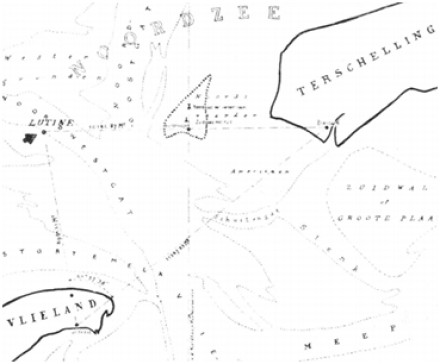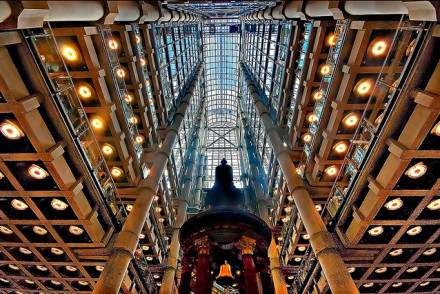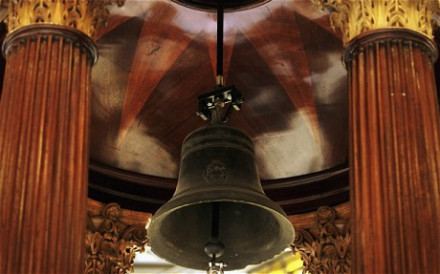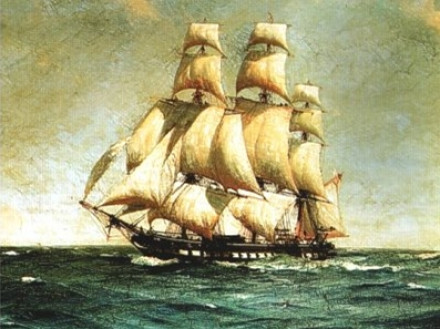History
Originally launched as a French Navy Magicienne-class frigate in 1779, the Lutine was captured by the British in 1793 during the French Revolutionary wars, at the Siege of Toulon. After the siege, the vessel was refitted by the British Navy as a 38-gun fifth-rate frigate. During the Second Coalition of the war, an attempt by the monarchs of Russia, Austria and Great Britain to eliminate the influence of Revolutionary France in Europe, HMS Lutine came to serve as an escort. She was mainly involved in guiding transports in and out of the shoal waters around the north of the Batavian Republic – a French client state and successor to the Dutch Republic.
In 1799, an imminent crash of the important Hamburg stock market threatened to topple Britain's German ally, and in order to cover the loans that had been granted on the German market, a large sum of money was needed. In response, the Lutine was employed by the British to carry about £1,200,000 (equivalent to about €95,000,000) in gold and silver from Yarmouth to Cuxhaven. The cargo never reached its destination. Instead, during a heavy storm in the evening of October 9, the ship was drawn by the tidal stream onto a Wadden Sea sandbank off Terschelling. There, the Lutine sank, taking all but one of her 240-odd passengers and the entire cargo with her.

Insurance
For two centuries, researchers have wondered why experienced captain Lancelot Skynner had deviated from course and ventured out into the treacherous waters of the estuary between Vlieland and Terschelling. According to a recent archival study, Lutine was on another, secret mission to North Holland, where it was to provide combat pay to the English troops fighting Napoleon's army. Presumably the reason for the detour was kept secret, in order to secure financial compensation by the English maritime insurance company Lloyd's.

Salvage of Lutine
Salvage attempts of the wreck of the Lutine began almost immediately after her sinking on behalf of multiple parties. Since the Dutch were involved in the war with England on behalf of the French at the time, the salvage rights were claimed as a war prize. The other party was Lloyd's of London, an English insurance company which paid the insurance claims on the bullion and specie. The location of the wreck made salvage efforts incredibly difficult, and these initial efforts were ultimately unsuccessful.
Attempts at recovering the cargo of Lutine continued throughout the following decades, and various expeditions yielded a variety of items, such as gold and silver bars and specie, some cannon, the bower anchors, grapeshot, and Lutine's bell in 1858. The last salvage attempt was in 1938.
Lutine's Bell
The bell salvaged from the wreck site of Lutine has hung in the Underwriting room of Lloyd's of London since it was salvaged. Traditionally it was rung to announce the news of ships that were late to arrive at their destination. It was rung once for bad news or news of the loss of a ship, and twice for good news, such as the safe return of a missing vessel. It was rung so that all of the employees with an interest in the vessel would be assured of receiving the news at the same time. The tradition was discontinued after the bell developed a crack, and is now only rung to mark important occasions, such as the death of a member of the royal family.


Description
- Associated with: French Royal Navy, French National Navy, British Royal Navy
- Depth: 3.6 m
- Guns: 38 (in British service)
HMS Lutine wrecked between the Dutch islands of Vlieland and Terschelling in 1799, carrying an exceptionally rich cargo. The shipwreck has been subject to a gold hunt ever since.

| Length | 141 feet (43 m) |
|---|---|
| Width | 37 feet (11.3 m) |
| Tonnage | 950 ton (475 last) |
Status
- Heritage status: not protected
- Condition: (partly) preserved in situ, published archaeological documentation not available
- Institutions involved: Cultural Heritage Agency of the Netherlands
Salvage attempts on the Lutine are taking place to this day. However, the wreck is only seldom revealed by the shifting sands of the Wadden Sea. No information is available on the condition of the wreck, although it is expected to have been left heavily damaged. An estimated €20,000,000 in gold and silver is estimated to remain on the bottom of the sea.

References
- Hendriksma, M. (2013).
Lutine. De spannendste Nederlandse goudjacht ooit. - Huiskes, B. & G. de Weerdt (eds.) (1999).
De Lutine 1799-1999. De raadselachtige ondergang van een schip vol goud.
Gent. - Molen, S. J. Van der, 1970, The lutine Treasure. The 150-year search for gold in the wreck of the frigate Lutine, Adlard Coles.
London, U.K. - Strick, H. & J. Strick, 1986, Eenige aantekeningen betreffende de Lutine, Hoorn-Terschelling.